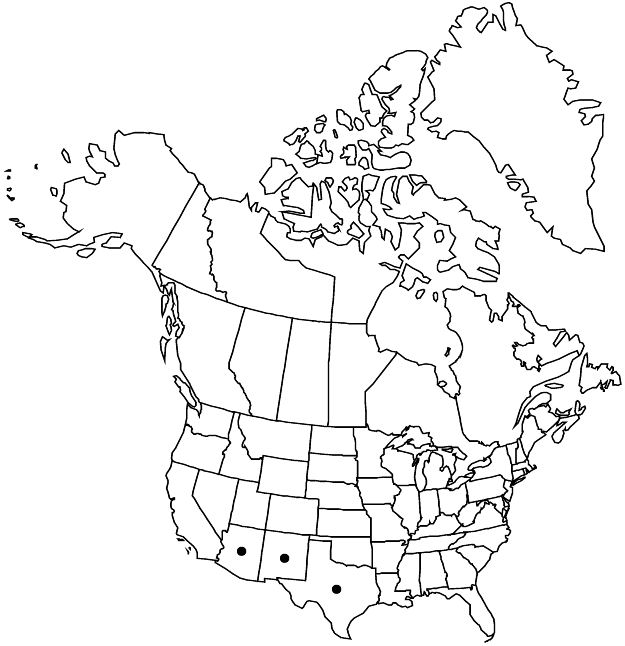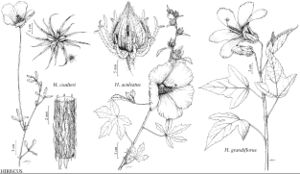Hibiscus coulteri
Smithsonian Contr. Knowl. 3(5): 23. 1852.
Subshrubs, to 2 m, herbage with appressed-stellate and simple hairs throughout. Stems: stellate hairs of younger stems dense, appressed, 4-armed, arms approximate in pairs, aligned with stem axis, lines of fine, curved hairs absent or obscured; older growth grayish, rough, glabrescent. Leaves: stipules linear-subulate, 3–10 mm; petiole primarily in distal 1/2, sometimes themselves shallowly pinnately lobed, surfaces scabridulous, hairs appressed-stellate, obscure nectary present abaxially on midvein near base. Inflorescences solitary flowers in axils of distal leaves. Pedicels jointed below apices, to 17 cm, usually much exceeding subtending leaves; involucellar bractlets 8–14, linear-subulate, 1–2 cm, margins ciliate. Flowers erect or ascending; calyx divided 3/4+ length, funnelform, 1.4–2.2 cm, equaling or slightly exceeding involucel, lobes narrowly lanceolate-triangular, margins ciliate, apices attenuate, nectaries absent; corolla rotate, petals yellow to cream, usually with dark to obscure maroon lines basally, asymmetrically obovate to broadly obovate, 1.6–4 × 1–3.5 cm, margins ± entire, sparingly hairy abaxially where exposed in bud; staminal column straight, yellow or cream, 0.6–1.4 cm, bearing filaments throughout, free portion of filaments not secund, 1–3 mm; pollen yellow-orange; styles cream, 1.5–5 mm; stigmas maroon or cream. Capsules pale olivaceous gray with darker median stripe on each valve, ovoid or ellipsoid, 0.7–1.7 cm, to 2/3 calyces, apex rounded, hairy near apex or glabrous throughout. Seeds dark-brown, angulately reniform-ovoid, 2.4–3 mm, silky-hairy ± throughout.
Phenology: Flowering nearly year-round.
Habitat: Desert, rocky slopes
Elevation: 600–1600 m
Distribution

Ariz., N.Mex., Tex., Mexico (Baja California), Mexico (Chihuahua), Mexico (Coahuila), Mexico (Durango), Mexico (Nuevo León), Mexico (Sonora), Mexico (Zacatecas)
Discussion
Hibiscus coulteri has been recorded in the southern half of Arizona; in Otero County, New Mexico; and in the region west of the Pecos River in Texas.
A naturally occurring hybrid between Hibiscus coulteri and H. denudatus (Hibiscus ×sabei Weckesser) has recently been documented from western Texas (W. Weckesser 2011).
Selected References
None.
Lower Taxa
"fine" is not a number.
